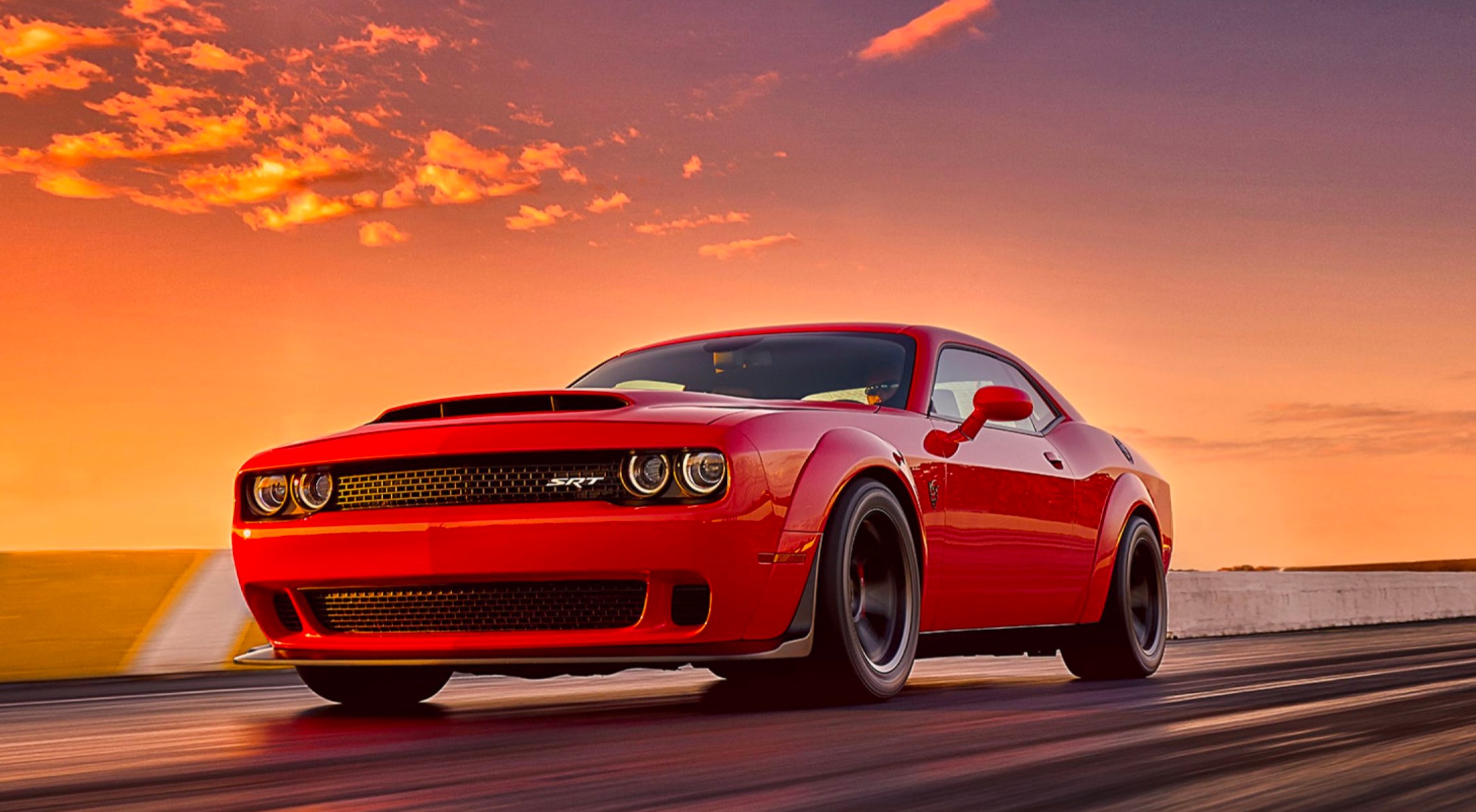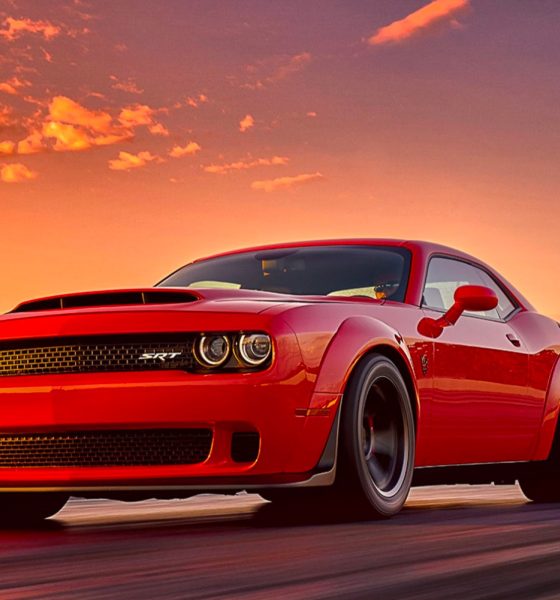

News
Dodge “Demon” looks to dethrone Tesla’s title for “quickest production car” in the world
Tesla sent shock waves through the automotive world in February when Motor Trend crowned the Model S P100D the quickest production car in the world after a 2.28 second run to 60 miles per hour. Do a few hundredths of a second really matter? In the real world, no. But in terms of image, they matter a great deal. Tesla garnered an enormous amount of valuable publicity from the Motor Trend story, and subsequently many 1/4 mile world records being set in a P100D.
Dodge has now responded to the marker laid down by Tesla. Starting this fall, it will offer a special edition of the Dodge Challenger SRT called the “Demon”. Dodge says it can scamper to the magic 60 mile per hour mark in 2.1 seconds, which will allow it to claim the title of quickest production car in the world.
The Demon features a great honking beast of a V8 engine topped with an enormous supercharger and compound intercooling. The Demon engine has 808 horsepower and 717 lb-ft of torque when running on 91 octane pump gas. Put 100+ octane racing fuel in the tank and it’s capable of 840 hp and 770 lb-ft of torque. There’s a big button on the dash the driver can push to change the engine mapping in order to extract maximum power from the racing gas.
The Demon comes from the factory with a driver’s seat and a two speaker stereo. It has almost no sound insulation and no carpeting. The car has smaller brakes and hollow antiroll bars to save weight. If the customer really needs a passenger seat, one can be added for $1 when the order is placed ($1,160 if purchased later). A back seat is available for another $1. A 19-speaker sound system can also be specified.
The Demon is the result of a two year campaign by a small team of 25 Dodge engineers. Compared to the engine in the Hellcat, the Demon’s power plant has 97 new parts including a new crankshaft, new connecting rods, new pistons, a new steel camshaft, and a new valve train. A larger supercharger is fitted and boost pressure is raised from 11.6 psi to 14.5 psi. The engineers also altered the software that controls the eight speed automatic transmission to add a transbrake function. In Drag mode, it allows the engine to build power while the car remains stationary until a flick of the paddle shifter unleashes the beast.
- Credit: Dodge
Photo credit: Motor Trend
“Sometimes you need to ignore the data, disregard the focus groups, and build a car that can define itself,” says Dodge President Tim Kuniskis. “A lot of halos don’t have the greatest business cases.” The halo effect the Hellcat did not go unnoticed in the Dodge board room. While sales of the Hellcat were minimal, orders for the Scat Pack, a special appearance package comprised of stripes, stickers and decals, exploded. 17% of Dodge Challenger buyers now opt for the Scat Pack, an idea that harks back to the muscle car days of the 1960’s.
The Dodge Demon may be a production car, but its numbers will be limited. Only 3,300 will be built — 3,000 for the US market and 300 for Canada. It is definitely intended for serious racers. It can be ordered with The Crate, a box full of go fast goodies that fits in the trunk and includes skinny wheels and tires for the front end on track day. It also contains a special air filter, a tire pressure gauge, and a leather bound manual with tips on how to go drag racing and pages to record data from each run.
There is no doubt the Dodge Demon is an awesome car with brutal acceleration. Its 0-60 run in 2.1 seconds has been verified. But as Motor Trend points out, that feat was achieved at a drag strip, where years of racing have coated the track surface with sticky rubber. The Tesla Model S P100D record was achieved on a public road. The Model S also seats 5 in supreme comfort and is just as happy taking the family to Easter dinner as it is performing banzai runs to 60. The Models S is also a zero emissions vehicle. The Dodge Demon? Not so much.
Still, bragging rights are all about one thing — being quicker than the other guy. Once the Demon hits the streets, we can expect P100D drivers to challenge the new Challenger. Let the Dodge Demon versus Model S drag racing videos begin!

Elon Musk
Elon Musk and Tesla AI Director share insights after empty driver seat Robotaxi rides
The executives’ unoccupied tests hint at the rapid progress of Tesla’s unsupervised Robotaxi efforts.

Tesla CEO Elon Musk and AI Director Ashok Elluswamy celebrated Christmas Eve by sharing personal experiences with Robotaxi vehicles that had no safety monitor or occupant in the driver’s seat. Musk described the system’s “perfect driving” around Austin, while Elluswamy posted video from the back seat, calling it “an amazing experience.”
The executives’ unoccupied tests hint at the rapid progress of Tesla’s unsupervised Robotaxi efforts.
Elon and Ashok’s firsthand Robotaxi insights
Prior to Musk and the Tesla AI Director’s posts, sightings of unmanned Teslas navigating public roads were widely shared on social media. One such vehicle was spotted in Austin, Texas, which Elon Musk acknowleged by stating that “Testing is underway with no occupants in the car.”
Based on his Christmas Eve post, Musk seemed to have tested an unmanned Tesla himself. “A Tesla with no safety monitor in the car and me sitting in the passenger seat took me all around Austin on Sunday with perfect driving,” Musk wrote in his post.
Elluswamy responded with a 2-minute video showing himself in the rear of an unmanned Tesla. The video featured the vehicle’s empty front seats, as well as its smooth handling through real-world traffic. He captioned his video with the words, “It’s an amazing experience!”
Towards Unsupervised operations
During an xAI Hackathon earlier this month, Elon Musk mentioned that Tesla owed be removing Safety Monitors from its Robotaxis in Austin in just three weeks. “Unsupervised is pretty much solved at this point. So there will be Tesla Robotaxis operating in Austin with no one in them. Not even anyone in the passenger seat in about three weeks,” he said. Musk echoed similar estimates at the 2025 Annual Shareholder Meeting and the Q3 2025 earnings call.
Considering the insights that were posted Musk and Elluswamy, it does appear that Tesla is working hard towards operating its Robotaxis with no safety monitors. This is quite impressive considering that the service was launched just earlier this year.
Elon Musk
Starlink passes 9 million active customers just weeks after hitting 8 million
The milestone highlights the accelerating growth of Starlink, which has now been adding over 20,000 new users per day.

SpaceX’s Starlink satellite internet service has continued its rapid global expansion, surpassing 9 million active customers just weeks after crossing the 8 million mark.
The milestone highlights the accelerating growth of Starlink, which has now been adding over 20,000 new users per day.
9 million customers
In a post on X, SpaceX stated that Starlink now serves over 9 million active users across 155 countries, territories, and markets. The company reached 8 million customers in early November, meaning it added roughly 1 million subscribers in under seven weeks, or about 21,275 new users on average per day.
“Starlink is connecting more than 9M active customers with high-speed internet across 155 countries, territories, and many other markets,” Starlink wrote in a post on its official X account. SpaceX President Gwynne Shotwell also celebrated the milestone on X. “A huge thank you to all of our customers and congrats to the Starlink team for such an incredible product,” she wrote.
That growth rate reflects both rising demand for broadband in underserved regions and Starlink’s expanding satellite constellation, which now includes more than 9,000 low-Earth-orbit satellites designed to deliver high-speed, low-latency internet worldwide.
Starlink’s momentum
Starlink’s momentum has been building up. SpaceX reported 4.6 million Starlink customers in December 2024, followed by 7 million by August 2025, and 8 million customers in November. Independent data also suggests Starlink usage is rising sharply, with Cloudflare reporting that global web traffic from Starlink users more than doubled in 2025, as noted in an Insider report.
Starlink’s momentum is increasingly tied to SpaceX’s broader financial outlook. Elon Musk has said the satellite network is “by far” the company’s largest revenue driver, and reports suggest SpaceX may be positioning itself for an initial public offering as soon as next year, with valuations estimated as high as $1.5 trillion. Musk has also suggested in the past that Starlink could have its own IPO in the future.
News
NVIDIA Director of Robotics: Tesla FSD v14 is the first AI to pass the “Physical Turing Test”
After testing FSD v14, Fan stated that his experience with FSD felt magical at first, but it soon started to feel like a routine.

NVIDIA Director of Robotics Jim Fan has praised Tesla’s Full Self-Driving (Supervised) v14 as the first AI to pass what he described as a “Physical Turing Test.”
After testing FSD v14, Fan stated that his experience with FSD felt magical at first, but it soon started to feel like a routine. And just like smartphones today, removing it now would “actively hurt.”
Jim Fan’s hands-on FSD v14 impressions
Fan, a leading researcher in embodied AI who is currently solving Physical AI at NVIDIA and spearheading the company’s Project GR00T initiative, noted that he actually was late to the Tesla game. He was, however, one of the first to try out FSD v14.
“I was very late to own a Tesla but among the earliest to try out FSD v14. It’s perhaps the first time I experience an AI that passes the Physical Turing Test: after a long day at work, you press a button, lay back, and couldn’t tell if a neural net or a human drove you home,” Fan wrote in a post on X.
Fan added: “Despite knowing exactly how robot learning works, I still find it magical watching the steering wheel turn by itself. First it feels surreal, next it becomes routine. Then, like the smartphone, taking it away actively hurts. This is how humanity gets rewired and glued to god-like technologies.”
The Physical Turing Test
The original Turing Test was conceived by Alan Turing in 1950, and it was aimed at determining if a machine could exhibit behavior that is equivalent to or indistinguishable from a human. By focusing on text-based conversations, the original Turing Test set a high bar for natural language processing and machine learning.
This test has been passed by today’s large language models. However, the capability to converse in a humanlike manner is a completely different challenge from performing real-world problem-solving or physical interactions. Thus, Fan introduced the Physical Turing Test, which challenges AI systems to demonstrate intelligence through physical actions.
Based on Fan’s comments, Tesla has demonstrated these intelligent physical actions with FSD v14. Elon Musk agreed with the NVIDIA executive, stating in a post on X that with FSD v14, “you can sense the sentience maturing.” Musk also praised Tesla AI, calling it the best “real-world AI” today.










